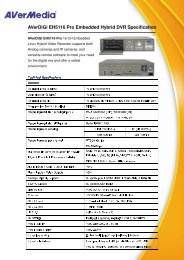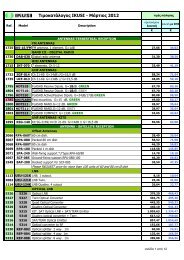ClassA - tridimas electronics
ClassA - tridimas electronics
ClassA - tridimas electronics
You also want an ePaper? Increase the reach of your titles
YUMPU automatically turns print PDFs into web optimized ePapers that Google loves.
<strong>ClassA</strong>TGT HEADEND• The TGT is a COFDM to COFDM TransportStream Regenerator/Processor. Theproduct is designed to correct and rebuilda poor quality COFDM signal back to QuasiTransmission Standard. The product alsoallows the user to change various parametersof the regenerated COFDM stream atthe output.• A TGT headend includes:- As many TGT Regenerators as COFDMchannels being received.- One or more AMX-400 combiners if theheadend being assembled is extensive.- One HPA Amplifier to launch the combinedoutput COFDM channels from theregenerators.- One or more CFP Power Supplies.- One or more Rack Frames or wall mountingBase Plates. The base plates can bejoined horizontally.- Housing units for the base plates ifrequired.- If the headend is large, one or moreAMX-400 combiners.The TGT headends deliver a multichannelCOFDM signal with sufficient power todrive a distribution network.An extension input at the HPA amplifierallows easy coupling of the wideband 47-862 MHz signal provided by other existingheadend equipment.FUNCTIONAL DESCRIPTION OF THE TGTREGENERATORSA TGT module carries out the complete CO-FDM stream regeneration plus full processingfrom input to output:- tunes a COFDM digital channel in the rangebetween 174-230 MHz or 470-862 MHzbands,- demodulates the received signal,- corrects errors within the actual COFDMdata stream,- processes the transport stream, and- re-modulates an errorless data stream intoan RF COFDM channel anywhere between47-862 MHz.Main features:- Central Input Frequency (125 kHz steps)- Bandwidth (7 or 8 MHz)- Hierarchy Level (high or low priority)- Central COFDM Output Frequency (1 kHzsteps)- Output Channel Bandwidth (6, 7 or 8 MHz;& 5 MHz for DVB-H)- Output Operation Mode (2K or 8K; & 4K forDVB-H)- Output Constellation (QPSK, 16QAM or64QAM)- Output Code Rate (1/2, 2/3, 3/4, 5/6 or 7/8)- Output Guard Interval (1/4, 1/8, 1/16 or 1/32)- RF Output Level- FFT Window (Fast Fourier Transform), toreduce interference on adjacent channel- In-depth Interleaving (only for DVB-H; with2K and 4K modes)- Optional Blockade of Services, PIDs andConditional Accesses, with Regenerationof Tables- NIT Regeneration (Adaptation)FUNCTIONS OF THE TS PROCESSING• Bit Rate adaptation with PCR restamping• Adaptation of NIT tableAdaptation to the particular adjustmentsof the headend is automatic. Name andidentifier of the new network can be edited.• Service and CA blockadeBlockade is at service level and at conditionalaccess level.Automatic regeneration of PAT, SDT andCAT tables.• TS monitoringUsage level of the Transport Stream —percentage of null packets— is presentedalong the programming process.• LCN insertion.• TS_ID, SID, ONID and NID edition.2HeadendsIKUSI · CATALOGUE 201353








